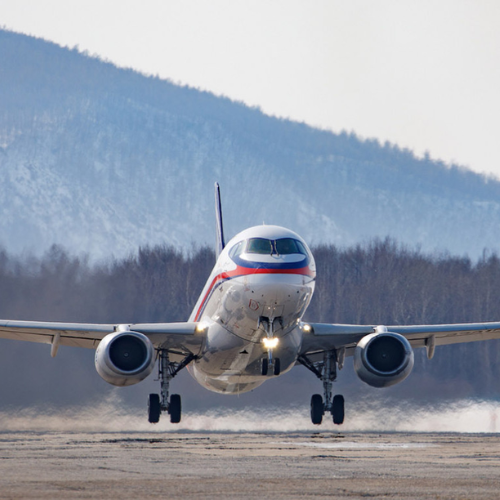Russia has taken a major step in its aviation industry by successfully testing the SJ-100 Superjet, a commercial aircraft built entirely with Russian-made components. This marks a historic achievement, as the country has now eliminated its dependence on Western-made parts. The aircraft, powered by the Russian-made PD-8 engine, completed its first test flight smoothly, defying Western sanctions meant to cripple Russia’s technological advancements.
According to state-owned company Rostec, the SJ-100 flew for 40 minutes, reaching an altitude of 3,000 meters (9,800 feet) and a speed of 500 kilometers per hour (310 mph). The flight was conducted in Komsomolsk-on-Amur, a major aviation hub in Russia. Engineers confirmed that the aircraft performed as expected under different conditions, proving the effectiveness of its new domestic engine.
The SJ-100 replaces more than 40 Western-made components with Russian alternatives, including avionics, landing gear, and other crucial parts. This development is seen as a massive success for Russia’s import substitution strategy, which aims to make the country more self-reliant in key industries.
New Zealand Stands Firm Extends Russia Sanctions Until 2028
The Challenge of Building an All-Russian Aircraft
The Sukhoi Superjet program was first launched in 2011 and originally relied on Western technology, including critical engine components. However, after heavy sanctions were imposed in 2022, Russia was forced to rethink its aviation strategy. The country’s engineers had to rebuild the Superjet almost from scratch, replacing every foreign-made part with locally produced alternatives.
One of the biggest challenges was developing a fully Russian-made engine. The PD-8, now the heart of the SJ-100, was designed to replace the previously used French-Russian engine. This new turbofan engine is built entirely in Russia, proving the country’s ability to produce advanced aviation technology independently.
Rostec CEO Sergey Chemezov called the maiden flight a major breakthrough for Russia’s aerospace industry. He emphasized that despite extreme pressure and sanctions, the country managed to develop an advanced aircraft in record time. Engineers worked under tight deadlines to ensure that the SJ-100 met all safety and performance requirements.
Dmitry Yadrov, head of Russia’s aviation regulator Rosaviatsiya, highlighted the importance of the SJ-100 for the country’s airline industry. He noted that Russia’s air traffic is expected to grow by 1.5 times by 2030, making the production of domestic aircraft a national priority.
Tupras Stops Russian Oil Imports and Turns to Brazil for Crude Supply
Why the SJ-100 Matters for Russia’s Future
The SJ-100’s successful test flight carries significant weight beyond just aviation. It sends a strong message that Russia can still innovate and build high-tech products despite global restrictions. The aircraft’s development showcases the resilience of Russian engineers and the country’s ability to adapt to economic pressure.
Western countries have long dominated the aviation industry with giants like Boeing and Airbus. By launching an entirely domestic passenger jet, Russia is positioning itself as a competitor in the global aviation market. Some experts believe that Russia could export the SJ-100 to countries facing similar sanctions or those looking to reduce their reliance on Western technology.
With the SJ-100, Russia has proven that sanctions have not stopped its progress. The aircraft is expected to play a crucial role in expanding domestic air travel, supporting Russia’s goal of complete aviation independence. While challenges remain, the successful flight of the SJ-100 marks a historic milestone in Russia’s aerospace industry.



